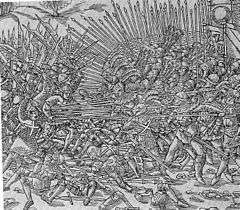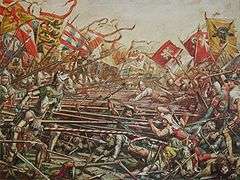Battle of Sempach
| Battle of Sempach | |||||||
|---|---|---|---|---|---|---|---|
| Part of the expansion of the Swiss Confederation | |||||||
 The battle scene in the fresco in the battle chapel at Sempach. 1886 restoration of a 17th-century painting, which was in turn based on a 16th-century work. | |||||||
| |||||||
| Belligerents | |||||||
|
| |||||||
| Commanders and leaders | |||||||
|
|
Johann von Ochsenstein † Johann von Waldburg † | ||||||
| Strength | |||||||
| ca. 6,000-8,000 | ca. 4,000, including 1,500 knights | ||||||
| Casualties and losses | |||||||
|
ca. 200 800 mercenaries | ca. 1,500, among them ca. 400 noblemen[1] | ||||||
The Battle of Sempach was fought on 9 July 1386, between Leopold III, Duke of Austria and the Old Swiss Confederacy. The battle was a decisive Swiss victory in which Duke Leopold and numerous Austrian nobles died. The victory helped turn the loosely allied Swiss Confederation into a more unified nation and is seen as a turning point in the growth of Switzerland.
Background
During 1383 and 1384, the expansion of the Old Swiss Confederacy collided with Austrian interests. The interests of Austria were further undermined in the Pact of Constance, a union of Zürich, Zug, Solothurn and 51 cities of Swabia.[2] In 1385, there were various attacks, without formal declaration of war or central organization, by forces of Zürich, Zug and Lucern on the Austrian strongholds of Rapperswil, Rothenburg Cham and Wolhusen.
In January 1386, Lucerne expanded its sphere of influence by entering pacts with a number of towns and valleys under Austrian control, including Entlebuch, Sempach, Meienberg, Reichensee and Willisau. This move was the immediate cause of war. A local Austrian force defeated the confederate garrison at Meienberg. On 14 January, Lucerne called the confederaces for assistance. An armistice was called on 21 February, and negotiations were held in Zürich.[2] But neither side had any real interest in ending the conflict at this point, and as the armistice ended, the conflict escalated into a full-scale military confrontation.
Duke Leopold gathered his troops at Brugg, consisting of his feudal vassals from Swabia, the Alsace, Aargau, Thurgau, Tyrol, as well as bourgeois forces of various towns and Italian, French and German mercenaries. In the course of a few weeks, no less than 167 noblemen, both secular and of the church, declared war on the Swiss. These declarations were sent to the Swiss diet in 20 packets, in order to increase the effect of shock. On 24 June, a messenger from Württemberg brought 15 declarations of war. Before all letters had been read, the messenger from Pfirt delivered another eight, and before he had finished speaking, letters from the lords of Schaffhausen were brought in. Another eight messengers arrived on the following day.
The gathering of Austrian forces at Brugg suggested an intended attack on Zürich, and the Confederate forces moved to protect that city. But Leopold marched south, to Zofingen and on to Willisau, apparently with the intention of ravaging the Lucerne countryside and perhaps ultimately aiming for the city of Lucerne. The Austrian army had a troop of mowers with them with the purpose of cutting down the corn and destroying the harvests along their route. The town of Willisau was plundered and burned, and the army moved on to Sursee on Lake Sempach, and thence towards Sempach on 9 July.
Leopold's men taunted those behind the walls of the town, and a knight waved a noose at them and promised them he would use it on their leaders. Another mockingly pointed to the soldiers setting fire to the ripe fields of grain, and asked them to send a breakfast to the reapers. From behind the walls, there was a shouted retort: "Lucerne and the allies will bring them breakfast!"
Confederate troops of Lucerne, Uri, Schwyz and Unterwalden had marched back from Zürich once it became clear that this was not Leopold's target. The forces of Zürich had remained behind defending their own city, while those of Bern had not heeded the confederate call for assistance.
The Battle

The Confederation army had presumably assembled at the bridge over the Reuss River at Gisikon. It marched from there, hoping to catch Leopold still at Sempach where he could be pressed against the lake. Around noon, the two armies made contact about 2 km outside of Sempach. This was to the mutual surprise of both armies, which were both on the move and not in battle order. But both sides were willing to engage and formed ranks. The site of the battle is marked by the old battle chapel, which was originally consecrated in the year after the battle.
The Swiss held the wooded high ground close to the village of Hildisrieden. Since the terrain was not deemed suitable for a cavalry attack, Leopold's knights dismounted, and because they did not have time to prepare for the engagement, they were forced to cut off the tips of their poulaines which would have hindered their movement on foot. The Swiss chroniclers report how a huge pile of these shoe-tips was found in a heap after the battle, and they are also depicted in the background of the battle scene in the Lucerne Chronicle of 1513.
The main body of the Confederation army finally completed its deployment from the marching column, formed up, and attacked the knights from the flank aggressively. The Austrian force, on the other hand, formed a wide rank and threatened to surround the outnumbered confederates.
How and at what point the battle turned in favour of the confederates is a matter of debate. It has been suggested that an important factor was the midday heat in July, which wore out the Austrian knights wearing heavy armour much more than the lightly armed confederates (some of which had reportedly no other "armour" than a wooden plank tied to their left arm as a shield). Another factor may have been a fatal underestimation of the confederates on the part of the nobility. According to the account by Tschudi, seeing the small strength of the confederate force, the nobles were concerned that if they sent the mercenaries in front, as would have been common practice, they might not see any action at all, as the mercenaries would finish the job on their own. Therefore, they insisted on taking the front ranks.
Traditional Swiss historiography since the 16th century has attributed the turning of the tide to the heroic deed of Arnold von Winkelried, who opened a breach in the Habsburg lines by throwing himself into their pikes, taking them down with his body so that the confederates could attack through the opening.[3] Winkelried is usually explained as a legendary figure introduced to explain the Swiss victory against the odds, perhaps as late as a full century after the battle. The earliest evidence of the Winkelried legend is the depiction of the battle in the Lucerne Chronicle of 1513. The oldest accounts of the battle are unambiguous in the judgement that the Swiss victory was against all odds and expectations, and is attributed to the grace of God.
In any case, the Swiss did break through the Austrian ranks and routed the enemy army completely. Duke Leopold and with him a large number of nobles and knights were slain, including several members of the noble families of Aarberg, Baldegg, Bechburg, Büttikon, Eptingen, Falkenstein, Hallwil, Reinach, Rotberg and Wetter.[2]
Aftermath


An armistice was agreed upon on 12 October, followed by a peace agreement valid for one year, beginning on 14 January 1387.
The battle was a severe blow to Austrian interests in the region, and allowed for the further growth of the Old Swiss Confederacy. Already weakened by the 1379 division of Habsburg lands, Leopoldian control of the territories left of the Rhine would collapse over the following years, not least due to the death toll among the local elites loyal to Habsburg. This allowed the confederate cities, especially Lucerne, Bern and Solothurn, an unchecked expansion into the undefended Habsburg lands. Bern, which had not participated in the Sempach war, took the opportunity and began its conquest of what would become the canton of Bern, sending military expeditions into the Jura, the Oberland, Emmental and Aargau. Lucerne by 1389 was able to consolidate its control over the towns around lake Sempach, Willisau and the Entlebuch, largely corresponding to the extent of the modern canton of Lucerne. Glarus also took the opportunity to rebel against Habsburg control and established its independence in the Battle of Näfels in 1388.
A new peace agreement between the confederacy and Austria was concluded on 1 April 1389, valid for seven years, extended to 20 years on 16 July 1394.[2]
Legacy


Not without justification, the Battle of Sempach came to be seen as the decisive turning point between the foundation of the confederacy as a loose pact in the 14th century, and its growth into a significant political and military power during the 15th century. At the peak of the military success of the Eight Cantons in the period of 1470 to 1510, Swiss historiography paid great attention to the Battle of Sempach. It is depicted in the Swiss illustrated chronicles of the period, and discussed by Reformation era historiographers such as Aegidius Tschudi and Wernher Steiner. Since there are few historiographical accounts of the battle predating 1470, it is difficult to judge the historicity of the individual details. The legend of Arnold Winkelried is recorded in this period, but it cannot be shown to predate 1500.
The battle chapel at Sempach was consecrated already in 1387. A yearly mass was celebrated there on the day of the battle.[2] The chapel was repeatedly enlarged. It was decorated with a fresco in 1551, which was restored and enlarged in 1638–1643, 1695, 1741–43, 1747, and 1886. The current fresco is largely a restoration of the painting of 1643.
Swiss patriotism in the restored Confederacy of 1815–1847 rediscovered the formative phase of the Old Confederacy as a source of national identity. The modern Sempacherlied is a product of 1830s patriotism. During the World Wars, the Swiss policy of armed neutrality was also ideologically fuelled by reference to the military successes of the medieval confederacy.
Swiss modernist author Robert Walser (1878–1956) recounts the Battle of Sempach in brief but violent detail in his short story "The Battle of Sempach".[4]
Notes
- ↑ Weber (1936) p. 42.
- 1 2 3 4 5 Battle of Sempach in German, French and Italian in the online Historical Dictionary of Switzerland.
- ↑ Winkelried, Arnold in German, French and Italian in the online Historical Dictionary of Switzerland.
- ↑ The English translation of Walser's story by Michael Wooff at Project Gutenberg
Sources
- Die Schlacht von Sempach im Bild der Nachwelt (exhibition catalogue), Lucerne, 1986.
- Delbrück, Hans (1990). Medieval Warfare. Lincoln: University of Nebraska Press. ISBN 0-8032-6585-9.
- Rainer Hugener, Erinnerungsort im Wandel. Das Sempacher Schlachtgedenken im Mittelalter und in der Frühen Neuzeit, in: Der Geschichtsfreund. Zeitschrift des Historischen Vereins Zentralschweiz 165, 2012, 135–171.
- Stefan Jäggi, Sempacherkrieg in German, French and Italian in the online Historical Dictionary of Switzerland.
- Theodor von Liebenau, Die Schlacht bei Sempach. Gedenkbuch zur fünften Säcularfeier, Lucerne (1886).
- G.P. Marchal, Sempach 1386, 1986.
- G.P. Marchal, Zum Verlauf der Schlacht bei Sempach, in: Schweizerische Zeitschrift für Geschichte 37, 1987, 428-436.
- Peter Xaver Weber, Der Sempacher Krieg. Erinnerungsschrift zur 550. Gedächtnisfeier der Schlacht bei Sempach, Lucerne (1936).
- Wheatcroft, Andrew (1996). The Habsburgs: Embodying Empire. London: Penguin Books. ISBN 0-14-023634-1.
See also
| Wikimedia Commons has media related to Battle of Sempach. |
Coordinates: 47°08′44″N 8°12′48″E / 47.14556°N 8.21333°E